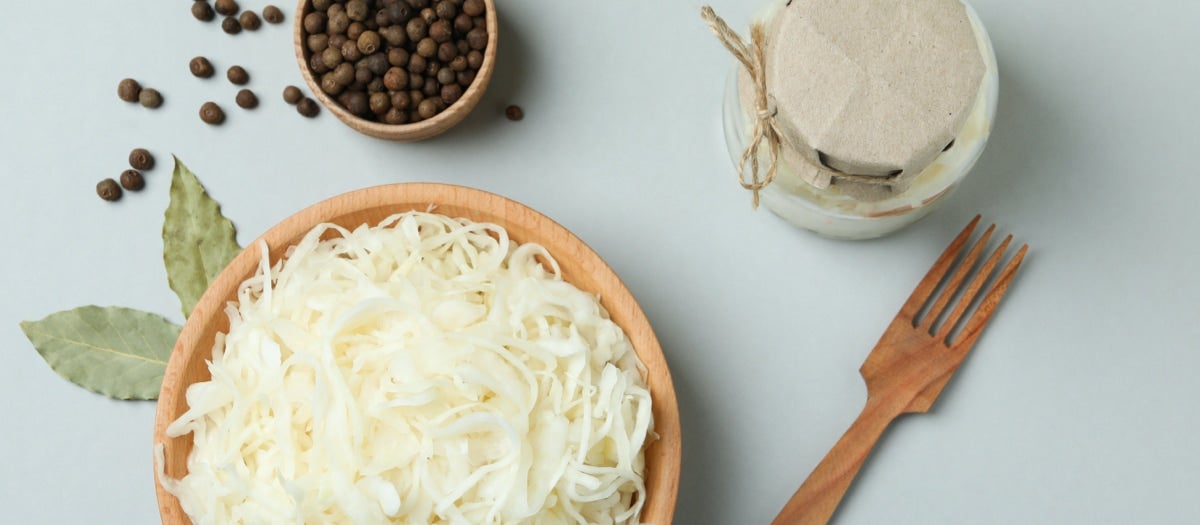Laktobazillen (Milchsäurebakterien)
Für Darmflora und Verdauung
In unserem Darm befinden sich zig Billion Bakterien – unter ihnen auch die sogenannten Laktobazillen. Anders als der Name vielleicht den Eindruck erweckt, sind Laktobazillen wertvolle Helfer für unsere Darmgesundheit. Gemeinsam mit den Bifidobakterien unterstützen sie aktiv die Darmflora für ein gesundes Darmmilieu.

Laktobazillen sind in fermentierten Lebensmitteln wie Joghurt, Quark oder Buttermilch und in Sauerkraut enthalten.
Laktobazillen spielen als Teil des so genannten Darmmikrobioms eine wichtige Rolle für unsere Darmgesundheit. Schon nach der Geburt gehören sie neben den Bifidobakterien zu den wichtigsten Bakterien im Darm. Sie werden beim Stillen mit der Muttermilch aufgenommen, verdrängen schädliche Bakterien im Darm und fördern die Entwicklung eines starken Abwehrsystems. Auch im Erwachsenenalter sind die Laktobazillen wichtige Vertreter unserer Darmflora: Sie unterstützen etwa die Verdauung und die Aufnahme von Nährstoffen.
Damit sich die Laktobazillen rundum wohl in unserem Darm fühlen, können wir das ein oder andere von außen beisteuern: Ein wichtiger Beitrag ist z.B. der Verzehr von fermentierten Lebensmitteln. Typisch für die Herstellung dieser Produkte sind die Milchsäurebakterien Lactobacillus acidophilus und Lactobacillus rhamnosus. Es wird empfohlen möglichst täglich Sauermilchprodukte wie Joghurt, Quark, Buttermilch und Kefir zu essen. Auch frisches Sauerkraut und Kimchi sind gute Quellen.
Gut zu wissen
Milchsäurebakterien wie Laktobazillen und Bifidobakterien werden auch als Probiotika bezeichnet. Übersetzt bedeutet dies „für das Leben“. Denn: Sie werden zugeführt, um unsere körpereigene Bakterienbesiedelung zu unterstützen. Auch in der Vagina finden sich Milchsäurebakterien wie Laktobazillen. Sie sind wichtig für eine funktionierende Vaginalflora und machen ganze 70% des vaginales Mikrobiom aus.
Einige Probiotika haben sich als besonders nützlich für die vaginale Gesundheit und während der Schwangerschaft erwiesen. Während manche direkt in die Vagina eingeführt werden, können andere auch oral eingenommen werden. Tatsächlich wurde festgestellt, dass selbst die orale Einnahme von bestimmten Lactobazillen, wie Lactobacillus acidophilus GLA-14 und Lactobacillus rhamnosus HN001, die Vaginalflora positiv beeinflusst und gegen wiederkehrende bakterielle Infektionen schützt [42, 43].
In Studien wurde außerdem nachgewiesen, dass oral eingenommene Probiotika auf Basis von Lactobazillen im Vergleich zu einem Placebo die Vaginalflora wiederherstellen und Symptome bei Frauen, die unter Vaginalmykosen oder bakterieller Vaginose leiden, deutlich lindern können [44, 45]. In Kombination mit einer Antibiotikabehandlungen, konnte die Einnahme eines Lactobazillen-basierten Probiotikum die Heilungsraten von bakterieller Vaginose von 50% mit Placebo auf beeindruckende 87% steigern [46].
Die positiven Effekte von Probiotika gehen jedoch über die vaginale Gesundheit hinaus. So wirkt Lactobacillus rhamnosus HN001 nicht nur gegen bakterielle Vaginalinfektionen [47], sondern kann auch das Risiko von Schwangerschaftsdiabetes verringern [48]. Zudem zeigen Untersuchungen, dass Lactobazillen-Probiotika das Risiko von wiederkehrenden Harnwegsinfekten deutlich senken können [49].
Interessanterweise hat sich Lactobacillus rhamnosus HN001 auch als wertvoll für die mentale Gesundheit von schwangeren Frauen erwiesen. Eine Studie mit 423 Schwangeren zeigte, dass diejenigen, die das Probiotikum von der Frühschwangerschaft bis 6 Monate nach der Entbindung eingenommen hatten, nach der Geburt deutlich weniger depressive und ängstliche Symptome aufwiesen im Vergleich zu denen, die nur ein Placebo erhielten [50].
Probiotika, insbesondere Lactobazillen, sind also vielversprechende Helfer für die Gesundheit von Frauen in verschiedenen Lebenslagen.
Die Kombination von Laktobazillen mit D-Mannose stellt sich als besonders effektiv heraus, insbesondere in der Prävention von wiederkehrenden Harnwegsinfektionen [53]. Der Einsatz von Nutraceuticals, zu denen D-Mannose, Cranberry und Laktobazillen gehören, zeigt bei unkomplizierten Harnwegsinfektionen ähnliche Ergebnisse wie konventionelle Antibiotika, jedoch ohne die mit Antibiotika verbundenen Risiken wie Nebenwirkungen und resistente Bakterienstämme [54].
Lactobazillen wie Lactobacillus acidophilus La-14® sind also Schlüsselakteure für die weibliche Gesundheit. Besonders in der Vagina schaffen sie das nötige saure Milieu, um eine gesunde Vaginalflora und somit einen starken Schutz vor Infektionen zu erhalten.
Doch dieser Stamm kann noch mehr. In speziellen Zellmodellen, gewonnen aus Zöliakie-Patienten, wurde festgestellt, dass Lactobacillus rhamnosus GG dazu beiträgt, eine übermäßige Immunreaktion zu mildern [56]. Er spielt auch eine Schlüsselrolle im Darm, indem er nicht nur eine Überproduktion von Entzündungsmarkern verhindert, sondern sich auch fest an die Darmschleimhaut anheftet, selbst wenn unerwünschte Organismen wie das Rotavirus zugegen sind [57, 58].
Diese Fähigkeiten sind nicht auf den Darm beschränkt. Lactobacillus rhamnosus GG hat auch gezeigt, dass er das Immunsystem unterstützen kann, insbesondere bei der Abwehr von Atemwegsinfektionen [59, 60]. Lactobacillus rhamnosus GG konnte z.B. in Form eines Nasensprays eine Infektion mit dem Grippevirus verhindern [61]. Ein weiterer interessanter Punkt: Er produziert spezifische Substanzen, die dazu beitragen, unser Immunsystem insgesamt zu stärken, darunter bestimmte Proteine und Polysaccharide [62].
Insgesamt zeigt Lactobacillus rhamnosus GG beeindruckende gesundheitliche Vorteile. Die Forschung unterstreicht das Potenzial dieses Probiotikums und betont die Synergie von Natur und Wissenschaft für unser Wohlbefinden.
1. Mendling, W., Vaginal microbiota. Microbiota of the human body: Implications in health and disease, 2016: p. 83-93.
2. Russo, R., A. Edu, and F. De Seta, Study on the effects of an oral lactobacilli and lactoferrin complex in women with intermediate vaginal microbiota. Archives of gynecology and obstetrics, 2018. 298: p. 139-145.
3. Russo, R., E. Karadja, and F. De Seta, Evidence-based mixture containing Lactobacillus strains and lactoferrin to prevent recurrent bacterial vaginosis: a double blind, placebo controlled, randomised clinical trial. Beneficial microbes, 2019. 10(1): p. 19-26.
4. Martinez, R., et al., Improved treatment of vulvovaginal candidiasis with fluconazole plus probiotic Lactobacillus rhamnosus GR‐1 and Lactobacillus reuteri RC‐14. Letters in applied microbiology, 2009. 48(3): p. 269-274.
5. Vujic, G., et al., Efficacy of orally applied probiotic capsules for bacterial vaginosis and other vaginal infections: a double-blind, randomized, placebo-controlled study. European Journal of Obstetrics & Gynecology and Reproductive Biology, 2013. 168(1): p. 75-79.
6. Martinez, R.C., et al., Improved cure of bacterial vaginosis with single dose of tinidazole (2 g), Lactobacillus rhamnosus GR-1, and Lactobacillus reuteri RC-14: a randomized, double-blind, placebo-controlled trial. Canadian journal of microbiology, 2009. 55(2): p. 133-138.
7. Bertuccini, L., et al., Effects of Lactobacillus rhamnosus and Lactobacillus acidophilus on bacterial vaginal pathogens. International Journal of Immunopathology and Pharmacology, 2017. 30(2): p. 163-167.
8. Wickens, K.L., et al., Early pregnancy probiotic supplementation with Lactobacillus rhamnosus HN001 may reduce the prevalence of gestational diabetes mellitus: a randomised controlled trial. British Journal of Nutrition, 2017. 117(6): p. 804-813.
9. Ng, Q.X., et al., Use of Lactobacillus spp. to prevent recurrent urinary tract infections in females. Medical hypotheses, 2018. 114: p. 49-54.
10. Slykerman, R., et al., Effect of Lactobacillus rhamnosus HN001 in pregnancy on postpartum symptoms of depression and anxiety: a randomised double-blind placebo-controlled trial. EBioMedicine, 2017. 24: p. 159-165.
11. Borges, S., J. Silva, and P. Teixeira, The role of lactobacilli and probiotics in maintaining vaginal health. Archives of gynecology and obstetrics, 2014. 289: p. 479-489.
12. Riley, M.A. and J.E. Wertz, Bacteriocins: evolution, ecology, and application. Annual Reviews in Microbiology, 2002. 56(1): p. 117-137.
13. Del Popolo, G. and F. Nelli, Recurrent bacterial symptomatic cystitis: A pilot study on a new natural option for treatment. Archivio Italiano di Urologia e Andrologia, 2018. 90(2): p. 101-103.
14. Gromova, O. and I.Y. Torshin, Regarding the prospects of using Lactobacillus-based probiotics, D-mannose and cranberry extracts in therapy of urinary tract infections. Obstetrics, Gynecology and Reproduction, 2023. 17(4): p. 485-499.
15. Pagnini, C., et al., Safety and Potential Role of Lactobacillus rhamnosus GG Administration as Monotherapy in Ulcerative Colitis Patients with Mild–Moderate Clinical Activity. Microorganisms, 2023. 11(6): p. 1381.
16. Furone, F., et al., The protective role of Lactobacillus rhamnosus GG postbiotic on the alteration of autophagy and inflammation pathways induced by gliadin in intestinal models. Frontiers in Medicine, 2023. 10: p. 1085578.
17. Pena, J.A. and J. Versalovic, Lactobacillus rhamnosus GG decreases TNF‐α production in lipopolysaccharide‐activated murine macrophages by a contact‐independent mechanism. Cellular microbiology, 2003. 5(4): p. 277-285.
18. Juntunen, M., et al., Adherence of Probiotic Bacteria to Human Intestinal Mucus in Healthy Infants and during Rotavirus Infection. Clinical Diagnostic Laboratory Immunology, 2001. 8(2): p. 293-296.
19. Gao, J., et al., A novel postbiotic from Lactobacillus rhamnosus GG with a beneficial effect on intestinal barrier function. Frontiers in microbiology, 2019. 10: p. 477.
20. Bornholdt, J., et al., Personalized B cell response to the Lactobacillus rhamnosus GG probiotic in healthy human subjects: a randomized trial. Gut microbes, 2020. 12(1): p. 1854639.
21. Harata, G., et al., Intranasal administration of Lactobacillus rhamnosus GG protects mice from H1N1 influenza virus infection by regulating respiratory immune responses. Letters in applied microbiology, 2010. 50(6): p. 597-602.
22. Segers, M.E. and S. Lebeer, Towards a better understanding of Lactobacillus rhamnosus GG-host interactions. Microbial cell factories, 2014. 13(1): p. 1-16.

